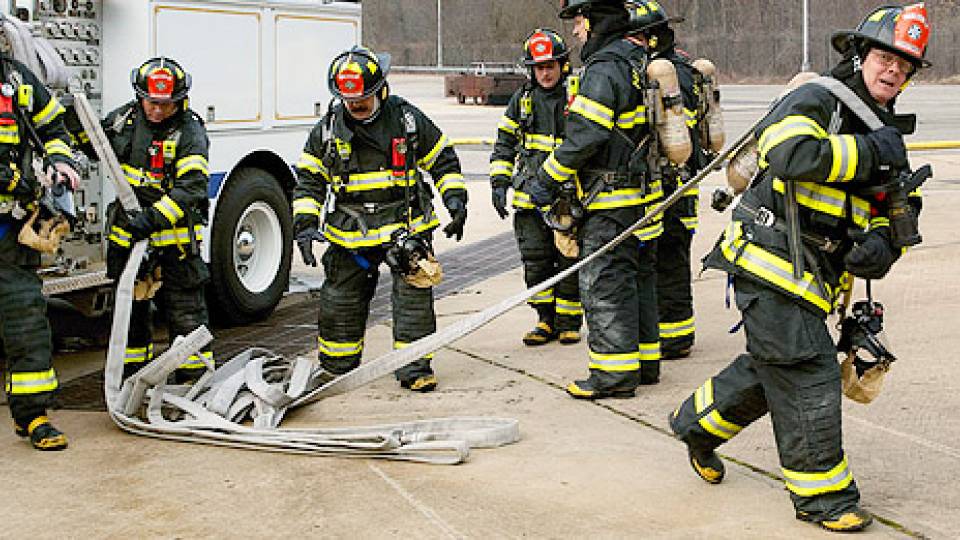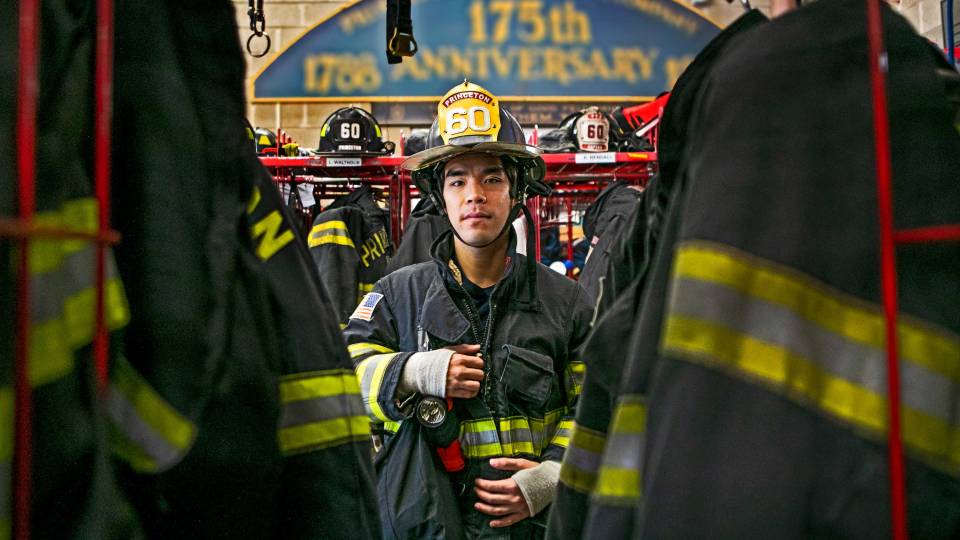When the local fire department responded to Princeton University’s Frick Chemistry Laboratory last spring, they found Michael Kervan on scene ready to help. Kervan is both a member of the University’s volunteer firefighter program and a senior maintenance mechanic in Frick Laboratory.
“I was able to help other firefighters quickly navigate the lab’s mechanical systems using my knowledge from working inside Frick every day. If I was not part of the Princeton Fire Department, I would have had to evacuate the building with everyone else,” said Kervan, who also is chief of his hometown volunteer department in Cranbury, N.J.
Though the incident involving a broken chemical container turned out to be minor, Kervan’s story is just one example of how the Princeton Fire Department Associate Member Program has benefited the campus and greater community during the past three-plus years.

An instructor from the Mercer County Fire Academy guides University firefighters as they extinguish flames from a dummy car during a recent training. “The object of the exercise is to watch out for all the hazards that may be in the car. It also gives everyone a chance to build teamwork and camaraderie,” said firefighter Sandra Kearney, an administrative assistant in Facilities.
The program allows University employees to volunteer with the Princeton Fire Department during their work shifts, augmenting the municipality’s volunteer ranks during critical daytime hours. The University also provides release time for staff to attend certification classes and trainings during business hours, with approval from supervisors.
“The University’s partnership with our department has been a godsend,” Princeton Fire Chief Dan Tomalin said. “Our membership has been on the decline for the past 10 years and it’s always hard for volunteer departments to rally firefighters during the day because people are busy working.”
Launched as a pilot in 2009(Link is external), the associate firefighter program became permanent in 2011 and has grown from 24 to 30 University volunteers. The majority of members work in Facilities(Link is external), Public Safety(Link is external), and Environmental Health and Safety(Link is external). While most participants had experience, eight employees were certified through the program. Eight new members will join the ranks after going through the training process this spring.

A dummy car was used as part of a recent firefighter drill at the Mercer County Fire Academy. Members of the University’s volunteer firefighter program may attend certification classes and trainings during business hours, with approval from supervisors.
While University faculty, staff and students have long volunteered on their own with the fire department, as well as the Princeton First Aid and Rescue Squad, this is the first formal partnership of its kind between the University and the Princeton Fire Department.
“It is unusual for a town the size of Princeton to still be protected by an all-volunteer fire department,” Director of Community and Regional Affairs Kristin Appelget said. “Our University staff can have a hands-on, immediate impact on the greater community by supporting a critical emergency service.”
Princeton Administrator Robert Bruschi said he knows of no other community where a university and municipal fire department “have come together in the way we have in Princeton.”
“Throughout many areas of the country, fire companies are facing extinction because of the shortage of volunteers,” Bruschi said. “Our collaboration has proven to be nothing short of an extremely successful program that benefits not only the community but the University.”

Members of the University’s volunteer firefighter program, shown here on Cannon Green, received a welcome benefit this past summer when the Princeton Fire Department provided volunteers with a reserve fire engine. The engine allows University volunteers to respond to calls in town and on campus more quickly.
More firefighters to help ‘town’ and ‘gown’
University volunteers have an on-call day Monday through Friday, ensuring at least six firefighters from campus are usually available during the workday.
“As soon as that pager goes off, we are members of the Princeton Fire Department,” said Assistant Vice President for Facilities Roger Demareski, who helped launch the program and also is a member.
Demareski said the volunteer squad received a welcome benefit over the summer when the fire department provided the University members with a reserve fire engine. Before, employees would meet on campus, drive to the Witherspoon Street fire station and then get on a fire truck. Now, they gather their gear, hop on the engine stored at 306 Alexander St., and head directly to a call.
“The engine has cut our response time by five minutes or so, which is huge when you are talking about a possible fire,” said Craig Stapfer, operations and safety coordinator for Facilities’ Site Protection department.
Stapfer, Kervan and Thomas Hewitt, also of the Site Protection department, are experienced firefighters and help coordinate the University program.

During a recent training, teams of firefighters planned their approach before one methodically opened the car’s back hood and doors with a metal tool so other firefighters could spray the car down with a hose from a nearby fire engine.
Established in 1788, the Princeton Fire Department is one of the country’s oldest fire departments. Municipal officials said maintaining a volunteer force, rather than having to pay firefighters, means considerable savings for taxpayers.
“The partnership with the University has pretty much solidified our daytime response. It’s been incredibly beneficial,” said Bob Gregory, director of emergency and safety services for Princeton, a municipal position supported by funding from the University and a federal grant.
Garth Walters, director of the University’s Office of Environmental Health and Safety, said the program has been a win-win for emergency officials on campus and in town.
“Providing the fire department with more personnel puts us all in a better place to get a quicker and more robust response,” he said. “When there is a call on campus, the University firefighters also can approach the situation with some familiarity of the building and its operations.”
Paying it forward
The program also has proved valuable beyond Princeton. Many of the University employees who became first-time firefighters also volunteer in their hometowns on nights and weekends.
“I would have never become a firefighter without the University because of the time commitment involved,” said Chris Shannon, a Site Protection mechanic and member of the Chews Landing Fire Department in Gloucester Township, N.J. “It takes a lot of dedication and a lot of training.”
Case in point: Shannon recently spent the morning at the Mercer County Fire Academy participating in a car fire drill with University volunteers and other members of the Princeton Fire Department.
Teams of five approached a dummy car obscured by thick gray smoke with flames shooting from its hood and trunk. Firefighters briefly planned their approach before one methodically opened the back hood and doors with a metal tool so other firefighters could spray the car down with a hose from a nearby fire engine.
“The object of the exercise is to watch out for all the hazards that may be in the car. It also gives everyone a chance to build teamwork and camaraderie,” said firefighter Sandra Kearney, an administrative assistant in Facilities and member of the Cranbury fire department.
As a longtime firefighter, Robert Allen said it’s great to see new people join the ranks through the University program.
“When you are depending on another firefighter to protect your life, it’s a strong bond,” said Allen, an architect and code analyst in the Office of Design and Construction(Link is external).
When asked to recall a particularly memorable incident that firefighters handled since they joined the associate program, most volunteers had the same answer.
“It’s any call — from something as small as a carbon monoxide detector alarm to a house fire,” Shannon said. “As soon as we arrive, you can see the person who called start to feel at ease because firefighters are on scene.”




